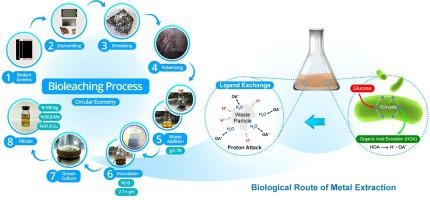Waste Management ( IF 7.1 ) Pub Date : 2021-06-22 , DOI: 10.1016/j.wasman.2021.06.006 Mehdi Golzar-Ahmadi 1 , Seyyed Mohammad Mousavi 2

|
With the alarming rate of e-waste generation, resource recovery from secondary metal sources is essential for sustainable resource utilization and to prevent the release of potentially toxic elements into the environment. In the current study, the first-time extraction of Ag, Mo, and Cu from active-matrix organic light-emitting diode (AMOLED) screens of discarded smartphones have been achieved using organic acids produced by Bacillus foraminis cultured on a modified Horikoshi medium. The influences of initial pH, inoculation size, and pulp density on the bioleaching process were evaluated over six-day experiment. Maximum extraction of Ag, Mo, and Cu (100, 56.8, and 41.4%) at optimal values of three investigated factors was obtained over a 12-day bioleaching experiment. A diverse assemblage of organic acid was produced in the optimized bioleaching condition, including tartaric (12.1 mM), formic (49.8 mM), acetic (21.5 mM), lactic (78.5 mM), citric (2.7 mM), and propionic (69.6 mM) acid. The contact angle analysis highlighted more hydrophobicity of powder after the bioleaching. FTIR and CHNO data also confirmed the role of bioleaching in the powder wettability alteration. The sequential extraction method revealed high mobility of In, Fe, Co, Cu, Cr, and Mo and low mobility of Ag. The results exhibited high tolerance of alkali-tolerant bacteria to potentially toxic elements and its superior performance in the bioleaching of discarded mobile screens at high pulp density.
中文翻译:

使用有孔芽孢杆菌作为耐碱菌株从智能手机中废弃的 AMOLED 显示器中提取有价值的金属
随着电子垃圾的产生速度惊人,从二次金属来源回收资源对于可持续资源利用和防止潜在有毒元素释放到环境中至关重要。在目前的研究中,利用有孔芽孢杆菌产生的有机酸,首次从废弃智能手机的有源矩阵有机发光二极管(AMOLED)屏幕中提取银、钼和铜。在改良的 Horikoshi 培养基上培养。在为期六天的实验中评估了初始 pH 值、接种量和纸浆密度对生物浸出过程的影响。在 12 天的生物浸出实验中,在三个研究因素的最佳值下获得了 Ag、Mo 和 Cu(100、56.8 和 41.4%)的最大提取率。在优化的生物浸出条件下产生了多种有机酸组合,包括酒石酸 (12.1 mM)、甲酸 (49.8 mM)、乙酸 (21.5 mM)、乳酸 (78.5 mM)、柠檬酸 (2.7 mM) 和丙酸 (69.6 mM) ) 酸。接触角分析突出了生物浸出后粉末的更多疏水性。FTIR 和 CHNO 数据也证实了生物浸出在粉末润湿性改变中的作用。顺序提取方法揭示了 In、Fe、Co、Cu、Cr 和 Mo 的高迁移率和 Ag 的低迁移率。









































 京公网安备 11010802027423号
京公网安备 11010802027423号